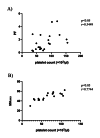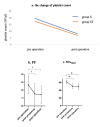Platelet Function Testing Using Sonoclot and TEG6s as a Platelet Transfusion Prediction Tool in Open Heart Surgery
- PMID: 38130528
- PMCID: PMC10733611
- DOI: 10.7759/cureus.49131
Platelet Function Testing Using Sonoclot and TEG6s as a Platelet Transfusion Prediction Tool in Open Heart Surgery
Abstract
Introduction The point-of-care test (POCT) is useful for blood coagulation management during cardiovascular surgery. Although thromboelastography (TEG6s) has been reported to have targeted benefits for blood transfusion in cardiac surgery, Sonoclot analysis has not yet been fully validated. In this study, we evaluated the accuracy of Sonoclot, especially platelet function (PF) as a platelet concentrate (PC) transfusion parameter, compared to TEG6s in cardiovascular surgery. Methods This single-center, prospective, randomised trial was conducted at a university hospital. Forty-two adult patients who underwent elective cardiac surgery requiring cardiopulmonary bypass were included in this study between 2017 and 2021. The participants were randomly assigned to the Sonoclot (S) or Sonoclot and TEG6s (ST) groups. The amount of intraoperative PC was determined according to the POCT parameter values at the time of protamine administration. In addition, we investigated the correlation between PF parameters of POCT and platelet count at the end of surgery. Results There was no statistically significant difference in the intraoperative PC volume between the two groups. The Sonoclot PF parameter, PF, was moderately correlated with platelet count at the end of surgery (r=0.5449, p=0.009), and the TEG6s PF parameter showed a strong correlation with platelet count at the end of surgery (r=0.7744, p<0.001). Conclusion There was no statistically significant difference in platelet transfusion volume between the Sonoclot and TEG6s in this study. The correlation between the PF of the Sonoclot and platelet count was moderate. This study suggests that PF of Sonoclot may be a potentiating indicator of PF.
Keywords: blood coagulation; cardiovascular surgery; sonoclot; thromboelastography; transfusion.
Copyright © 2023, Sato et al.
Conflict of interest statement
The authors have declared that no competing interests exist.
Figures






Similar articles
-
Comparison of two point of care whole blood coagulation analysis devices and conventional coagulation tests as a predicting tool of perioperative bleeding in adult cardiac surgery-a pilot prospective observational study in Japan.Transfusion. 2019 Nov;59(11):3525-3535. doi: 10.1111/trf.15523. Epub 2019 Oct 15. Transfusion. 2019. PMID: 31614002
-
Sonoclot® predicts operation time and blood loss after cardiopulmonary bypass in children.Heliyon. 2022 Nov 9;8(11):e11461. doi: 10.1016/j.heliyon.2022.e11461. eCollection 2022 Nov. Heliyon. 2022. PMID: 36387502 Free PMC article.
-
Comparison of coagulation monitoring using ROTEM and Sonoclot devices in cardiac surgery: a single-center prospective observational study.Minerva Anestesiol. 2022 Sep;88(9):680-689. doi: 10.23736/S0375-9393.22.16119-5. Epub 2022 Mar 22. Minerva Anestesiol. 2022. PMID: 35315620
-
Establishment of reference intervals and transfusion criterion for Sonoclot analysis.J Huazhong Univ Sci Technolog Med Sci. 2016 Aug;36(4):614-617. doi: 10.1007/s11596-016-1634-3. Epub 2016 Jul 28. J Huazhong Univ Sci Technolog Med Sci. 2016. PMID: 27465342
-
Blood coagulation and autologous blood transfusion in cardiac surgery.J Clin Anesth. 1990 Nov-Dec;2(6):393-406. doi: 10.1016/0952-8180(90)90026-y. J Clin Anesth. 1990. PMID: 2271204 Review.
References
-
- Blood conservation in cardiac surgery. Blaudszun G, Butchart A, Klein AA. Transfus Med. 2018;28:168–180. - PubMed
-
- Coagulation considerations for infants and children undergoing cardiopulmonary bypass. Eaton MP, Iannoli EM. Paediatr Anaesth. 2011;21:31–42. - PubMed
-
- Inhibition of platelet function by heparin. An etiologic factor in postbypass hemorrhage. John LC, Rees GM, Kovacs IB. https://www.jtcvs.org/article/S0022-5223(19)34155-8/pdf. J Thorac Cardiovasc Surg. 1993;105:816–822. - PubMed
-
- Efficacy of a simple intraoperative transfusion algorithm for nonerythrocyte component utilization after cardiopulmonary bypass. Nuttall GA, Oliver WC, Santrach PJ, Bryant S, Dearani JA, Schaff HV, Ereth MH. Anesthesiology. 2001;94:773–781. - PubMed
LinkOut - more resources
Full Text Sources
